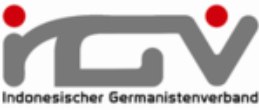TEXT ANALYSIS OF ONLINE LEARNING NEWS IN THE COVID-19 ERA IN GERMAN AND INDONESIAN ONLINE NEWSPAPERS
Abstract
This research examines the text analysis of online learning news in the COVID-19 era using the critical discourse analysis approach of the Teun A. van Dijk model. Teun A. van Dijk's critical discourse analysis research has three elements: text elements, social cognition elements, and social context. The text element is divided into macrostructure, superstructure, and microstructure. In the microstructure, two elements are to be analyzed: semantic and syntactic. This study aims to compare text elements, social cognition elements, and social context contained in the coverage of online learning in the COVID-19 era in German and Indonesian online newspapers. The object of this research focuses on three online newspapers, namely Süddeutsche Zeitung, Deutsche Welle, and Kompas. This research uses a qualitative approach with descriptive analysis. Data analysis techniques were collected by analyzing three elements of text: social cognition and social context. Then, the data were classified using tables to be compared and concluded. The results of the analysis of text elements in German and Indonesian online newspapers have similarities in which the text describes the relationship between the title of the discourse in the story and the content and cover, also has reasons that support the core topic and has direct quotes and coherence intertwined between schemes in the story, there are also important facts that are in the news. Furthermore, the elements of social cognition and context found media bias and social issues established by the news text. Based on the results of the study, a critical attitude when reading news is needed so that the audience is well-informed and understands the context of the news.
Keywords: Text Analysis, Critical Discourse Analysis, Online Newspapers, German Online NewspapersFull Text:
PDFReferences
Daniel, B., Peter, U., & Kornelia, E. (2015). Kritische Diskursanalyse: Darstellung anhand der Analyse der Nahostberichterstattung linker Medien. Technische Universität Berlin.
Eriyanto. (2002). Framing analysis of media construction, ideology and politics. LKiS.
Freeden, M., Lyman, T. S., & Stears, M. (2013). The Oxford handbook of political ideologies. OUP Oxford.
Hagen, L. M. (1998). Online-Medien als Quellen politischer Information. Westdeutscher Verlag.
Hall, S. (1997). Representation. SAGE Publication.
Hamborg, F. (2022). Revealing media bias in news articles. Springer.
Hidayah, S., Wihadi, M., & Rahmatunisa, W. (2023). Textual Metafunction Analysis about Education News Text on Selected National Online Newspapers. Journey: Journal of English Language and Pedagogy.
Mukhlis, M., Masjid, A., Widyaningrum, H., Komariah, K., & Sumarlam, S. (2020). Analisis Wacana Kritis Model Teun A. Van Dijk pada Surat Kabar Online dengan Tajuk Kilas Balik Pembelajaran Jarak Jauh Akibat Pandemi Covid-19. GERAM.
Neuberger, C., & Tonnemacher, J. (2013). Online Die Zukunft der Zeitung. Springer Fachmedien Wiesbaden.
Scharkow, M. (2011). Thematic content analysis using supervised machine learning: An empirical evaluation using German online news. Quality & Quantity, 47, 761–773.
Thye, I. (2013). Kommunikation und Gesellschaft-systemtheoretisch beobachtet. Springer.
Ullrich, P. (2015). Diskursanalyse, Diskursforschung, Diskurstheorie: Ein- und Überblick. Technische Universität Berlin.
Wilke, J. (2010). Massenmedien. UTB
DOI: https://doi.org/10.17509/alm.v13i2.71771
Refbacks
- There are currently no refbacks.
Copyright (c) 2024 Rifa Atila Putri Komara, Putrasulung Baginda

This work is licensed under a Creative Commons Attribution-ShareAlike 4.0 International License.
This journal provides immediate open access to its content on the principle that makes research freely available to the public and supports a greater global exchange of knowledge.
This work is licensed under a Creative Commons Attribution-ShareAlike 4.0 Internasional (CC BY-SA 4.0).

_(1)_(1)_(3)_.png)

